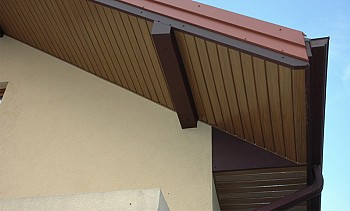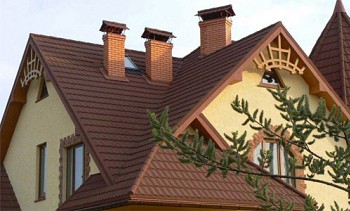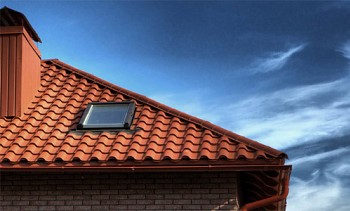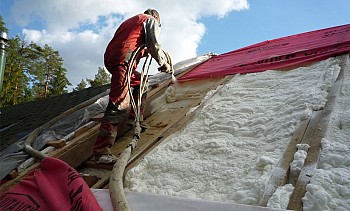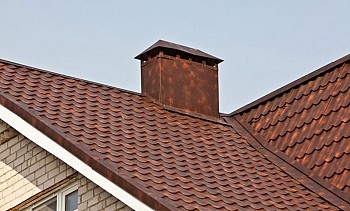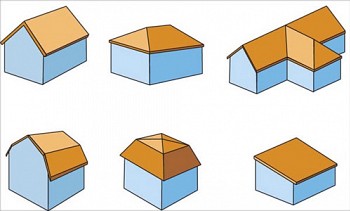If you neglect the warming of the room located under the roof of the house, or if you do it differently, then you won’t get into trouble. The cold wind will blow in the cracks in the winter, and moisture will accumulate in the form of condensate on the rafters and the ceiling. As a result, the tree will begin to mold and rot. And you’ll have to heat more, because the heat will partially disappear through the roof. Therefore, it is better to foresee everything in advance, learning how to properly insulate the attic and not make mistakes at the same time. So read on.
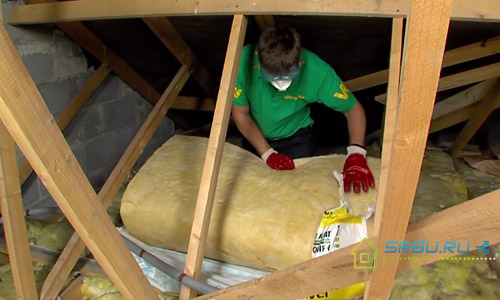
What material is better to use
There are not so few good heat insulators available today. The most popular are fiberglass and mineral wool. It is they that are used most often when warming the attic.
Fiberglass material is the cheapest. It is good because it does not burn, does not contain harmful components and organic substances. If fiberglass adheres tightly to the base, then it holds heat very well. But this happens only if the installation of the structure is made in compliance with all the subtleties of the technology.
Glass wool also has significant disadvantages. First of all, this is the presence of fine dust from fragments of glass fibers. It is very dangerous if such dust gets into your eyes. Do not let it get on the skin - it will begin to itch, and the scratches that appear will not heal for a long time. And when glass fragments soar in the air, nothing good comes of it. Togo and look, breathe this dust. But if you wear a respirator or a construction mask, then nothing bad will happen. And glass wool is inconvenient to use when warming walls that are inclined - because after a while this insulation will cease to fit snugly to them.
Cotton wool from mineral basalt fibers in many respects shows better results than glass wool. Its natural components are effectively complemented by synthetic ones, and as a result, the necessary balance is achieved. This material is lightweight and is not capable of causing such harm to health as fiberglass. Therefore, for the attic of a private house, this heater is preferable to use than glass wool. They are also very good at isolating plasterboard partitions to protect them from noise. After all, it delays sound much better than cotton wool made of glass threads.
An experienced professional builder who has been engaged in thermal insulation for a long time will not hesitate. When asked about how to insulate the attic with his own hands, he will answer that it is best to use stone wool from basalt fibers. Although it is somewhat more expensive, it is safer and more reliable in operation. Therefore, it often makes sense not to take a penny, but to choose the best option.
Mineral wool is usually produced either in the form of slabs of square shape, or in the form of a web folded into large rolls. It is convenient to insulate horizontal surfaces with such a carpet, and plates are good to use where the surfaces are vertical or are inclined.
Attic thermal insulation in stages
To begin with, we need to insulate structures around the entire perimeter of the room. The next step will be to protect the insulation from moisture, as well as organize vapor barrier and ventilation around the insulation loop.
- See the material: Vapor barrier - which side to the heater should it be properly laid and other features of the use of membranes
We produce the formation of a continuous insulated contour
The insulation layer should be laid on the roof, floors and partitions. If there is a pediment, then it should be insulated.
#1. Thermal insulation of the roof.
Since the roof slopes at the attic are sloping, they must be laid with material that does not change shape and size over time. Therefore, when deciding how to properly insulate the roof of the attic, it is better to take not a continuous sheet of basalt cotton wool, but a cut one (for example, in the form of plates). They can be easily interconnected during isolation. In order to reliably insulate the roof, the plates of the insulator are tightly inserted between its rafters. Additionally, the insulation is placed under the rafters or above them. At the same time, it is held by the crate, as shown in the figure.

If the width of the plate is insufficient and there is a gap, then it is filled with a strip of material cut off along the ruler with a knife. In this case, a centimeter of 2 or 2.5 is added with the expectation that stone wool can compress slightly over time. The resulting piece must be forced into the space between the slab and the rafters.
It is very important to carefully think through and insulate such complex elements as a ridge, overhangs, valley. Where the roof plane changes its shape, you must try to dock all the insulation parts well. This ensures the isolation of the insulating circuit. This is shown in detail in the following two figures.


Also, you should carefully pay attention to the places where the roof joins with walls and window openings. To prevent freezing, the attic windows should be insulated with a material of sufficient thickness, as shown in Figure 4.

As for the roof overhang, we provide moisture protection for it, as well as ventilation holes. How to do this, see the following figure.

#2. Insulation of floors.
When building a house with an attic, three types of floors can be used. Therefore, in this place, the insulation of the attic with your own hands is carried out in one of three ways.
- If the floors are made of reinforced concrete, and the floors are bulk or tiled, then the use of a particularly durable heat insulator is required. Not only that - it should also have good sound absorption. Therefore, in this case, the best option would be to use polystyrene foam material.

- If the floors are made of reinforced concrete, and the floors are wooden, laid with the help of a lag, then you can use basalt fiber boards for insulation. At the corners of the room leave holes for ventilation. So that extraneous sounds do not penetrate the overlap, we put the lags on special gaskets made of sound-absorbing material, see the figure.

- If the floors are made of wooden beams, then a draft floor is made above or below these beams. Thermal insulation material, in turn, is laid on this floor. Additionally, a moisture barrier must be provided, as shown in the figure.

On a flat, flat surface located horizontally, it is best to use a roll insulation. It is rolled out over the entire plane, while plugging the gaps between the rafters.
#3. Thermal insulation of the pediment.
For the pediment also use three methods of thermal insulation, which depend on the structure of the building.
- So, if the house was built using layered masonry, then the heat insulator is laid inside this masonry. Outside, there is a lining, and inside there is a load-bearing wall. To do this, it is best to use basalt wool in the form of plates. A vapor barrier layer is laid in the case when, according to the calculated data, the insulation will absorb water.
- The technology of “ventilated facade” also provides for the use of basalt fiber boards. Between them and the lining should be a space of 4 to 15 centimeters. To prevent the barrel from blowing in the attic, and the insulation not getting wet, we mount a special membrane. It will protect both from rain and wind, see Figure 8.

- If we have a plaster facade, then it is possible to take either polystyrene foam or tiled stone wool for insulation. In this case, the strength and geometric stability of the molds are important.
In the absence of the possibility of external warming of the walls of the frantones, you can apply internal warming of the walls, how to do this correctly see article:
#4. Partition insulation.
Wondering how to insulate the attic from the inside, they think about the isolation of its partitions. It is best to do this with mineral wool plates - the design will turn out to be quite light, non-combustible, perfectly retaining heat. These partitions are usually made on a frame with guides, which also play the role of supporting elements of the casing. This facilitates the installation of insulation. Slabs of mineral wool are placed either along these guides, or disputed. It should be noted that at the same time the noise can be well muffled. For better sound suppression, a layer of sound-absorbing material is placed between the partition and the floor, see figure.

Protect insulation from wind, rain and fumes
In order for the heat insulator to serve for a long time without losing its properties, it is necessary to lay a waterproofing layer both above and below it. Do not forget about ventilation. So that the insulation layer does not get wet from the condensation of vapors upon contact with a cold surface, we provide vapor barrier. It does not allow vapor diffusion outward. As a result, the insulation remains dry, and the walls with rafters do not rot and do not mold. The waterproofing layer not only protects from moisture, but also prevents the wind from blowing out heat, see figure.

Water that has fallen onto the roof after rain or snow is vented out via two-level ventilation. Its first level is located between the waterproofing and the roofing material, and the second between the heat insulator and the waterproofing layer. Inlet vents are made on the overhang, and the weekend on the ridge of the roof. In order for the heat-insulating material to be well ventilated, there are special ventilation devices in the moisture-proof film, see the figure.

The distance between the roof and the moisture-proof film should be at least 2 centimeters, otherwise the condensate will wet the insulation. To fix the film, special counter beams are mounted, the height of which is not less than 2.4 centimeters. The film should not be stretched, otherwise it may burst under the weight of flowing water when the air temperature changes.
It is very convenient to use special superdiffusion membranes - their use makes one of the ventilation levels superfluous. In this case, one layer of hydro and wind insulation, which is located above the insulation, is sufficient. And the air gap between the membrane and the heat insulator is no longer needed.
And now one more tip for those who want to know how to properly insulate the attic from the inside. The inner walls of the room located under the roof must be covered with a film for vapor barrier. It is fastened with brackets for a stapler, and at the joints it is carefully sealed with a special adhesive tape intended for such a film.

Basalt wool coated with a vapor barrier.
So, if you take into account all these recommendations, choose the right material and complete everything in the right sequence, then the result will certainly please. And you can be sure that neither the cold wind will penetrate your attic, nor will it get wet with snow and rain.

